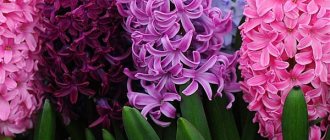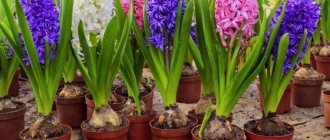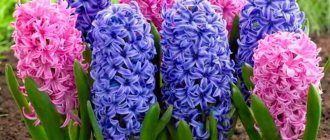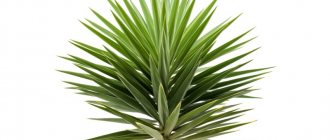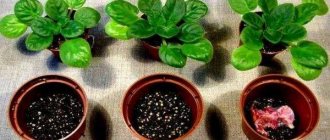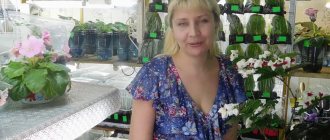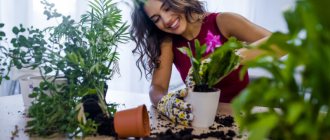A unique feature of this plant is that it floats on the surface of bodies of water (lakes, ponds, swamps). Water hyacinth came to us from South America. Grows successfully in all places with a tropical climate .
Hyacinth resembles a flower only in appearance; this plant lives only on water. In nature it grows quite quickly, entwining the water surface like a skillfully woven carpet.
Description of the plant
Another name is eichornia. Refers to annuals. The shoots are very tall (up to 2 meters), the leaves are rosette-type with compacted bases. They are porous inside . Thanks to this, the plant floats freely on water.
The roots are quite powerful, up to half a meter in length. They are not visible on the surface; they are completely hidden under the water column. Eichornia flowers are large, delicate, consisting of 6 petals, predominantly amethyst in color with a blue tint.
Characteristics
The flower got its name due to its resemblance to the ornamental plant hyacinth. However, the relationship between them has not been established, therefore Eichornia is considered a typically aquatic plant, the favorable environment for which is warm waters.
In nature, this plant blooms for many years. Its cuttings act as a kind of floats supporting a rather large rosette. If it blooms alone, then the swellings located on the cuttings are spherical in shape and large in size. If the plants form huge colonies, then these swellings become much smaller. Moreover, in the process of root formation they disappear altogether due to their uselessness.
Eichornia species
This plant blooms all summer long. But each bud pleases with its appearance for only forty-eight hours , after which the peduncle goes under water. Eichornia blooms especially brightly and abundantly in hot and rainy weather.
If a large number of hyacinths grow in a pond, during the budding period it turns into a bright carpet of incredibly beautiful shades .
The most popular types for aquariums and park ponds:
- Azure (on the picture). Leaves growing underwater have the shape of narrow pale green ribbons. The above-water part of the plant is characterized by bright oval leaves. Their surface has a ribbed structure. Designed for growing in an aquarium. Conditions are as close to tropical as possible.
- Variegated. It grows exclusively under water. Elongated leaves alternate with each other in different shades of green (from juicy emerald to light green). This is a plant requires less attention, reproduces well. Suitable for aquariums of different sizes.
- Centipede. It has glossy leaves of rich green color. The petioles are compacted. Flowers appear towards the end of summer and look very impressive. They are predominantly amethyst in color. On one of the six petals there is a spot in the shape of the card suit of spades indigo color with lemon flecks. Unfortunately, it is almost impossible to see such beauty at home. This species does not tolerate low thermometer readings.
Propagation of water hyacinth
Eichornia reproduces vegetatively. In an adult specimen, shoots form on the side shoots, which are separated from the main plant after the formation of 3-4 young leaves on them.
Gardeners should pay attention to the fact that eichornia shoots should be handled with care, since the juice of this plant contains a number of alkaloids that can cause a skin reaction in the form of itching and irritation.
the juice of this plant contains a number of alkaloids that can cause a skin reaction in the form of itching and irritation.
In its natural environment, the plant can reproduce by seeds. However, in a home aquarium it is difficult to obtain seed material. This requires temperatures above 35°C. Similar conditions can be created in special greenhouses. At home, a similar effect can be achieved with additional heating.
Features of planting and growing
This amazing plant can be cultivated both at home and outdoors . Planting and caring for it are easy. It is enough to create the right conditions for it so that the flower regularly delights with its beauty.
In the pond
First of all, you need to choose the right reservoir : shallow, in an open area, without drafts. Eichornia needs a lot of warmth and light. Before planting, the soil is fertilized with humus, compost or mullein. Sludge from the bottom (only purified) and complex fertilizer are also suitable. These substances are used for a feeding cycle throughout the year .
You need to wait for stable warm weather so that the water column warms up enough (at least to 25 - 30 degrees). A sharp contrast between day and night temperatures is undesirable. If the summer is cool, you shouldn’t expect flowers. They appear only in hot weather .
Important! Eichornia juice is quite toxic to humans, so any actions should be carried out with gloves.
In a home aquarium
There are practically no problems with this growing method . The limited water space allows you to create an exemplary ecosystem for maintenance.
But you will need a fairly large container; in a small one it may die. In addition, artificial lighting . Otherwise, the water hyacinth will not bloom.
Protection from diseases and pests
In general, Eichornia is unpretentious, but can suffer from fungal diseases. Rot occurs for several reasons :
- cold water;
- sudden changes in temperature;
- lack of light;
- nutrient-poor habitat.
A sign of rot is yellowing and blackening of the lower leaves . The plant must be removed from the water, damaged parts removed and kept in a solution of Fitosporin M and potassium permanganate.
Important ! Treatment of eichornia with a fungicide is possible if, after treatment, it is placed in a vessel without fish.
The plant can be damaged by spider mites, scale insects, and thrips. Usually, street specimens become victims, but indoor plants should also be inspected regularly. When plaque appears on the leaves or visible pests, the hyacinth is treated with an insecticide.
How to take care further?
Caring for eichornia consists of maintaining comfortable conditions. This will always allow you to have beautiful, healthy plants .
Water hyacinth needs the following conditions:
- High water temperature – starting from + 25 degrees.
- Acidity standards (pH) are 6 – 6.8, and the hardness index is not less than 6.
- Intensive lighting for 12 hours straight. Further illumination is not recommended. This activates the growth of green mass.
- In still water, mold quickly appears and a putrid odor spreads. To avoid this unpleasant situation, it is necessary to install devices for purifying water and saturating it with oxygen.
- Fertilizers can be used as fertilizers for both aquarium and indoor plants. Nutrients are added year-round , without regard to the season.
- Eichornia grows very aggressively and rapidly. Covering the entire surface of the water, it prevents oxygen and light from freely penetrating deep into the water. From time to time you need to get rid of overgrown specimens .
- There should be quite a lot of space for the crop to grow. In crowded conditions, plants for ponds will quickly die.
Many people are interested in whether pruning of eichornia is necessary. The answer to this question is unequivocal - yes. Moreover, the habitat does not play a role . This procedure is carried out both in an open reservoir and in an indoor aquarium (especially if fish live in it).
When horizontal shoots that have grown in large numbers appear, you can get rid of them. In summer, the petioles near the leaves often die off. This is normal. In this case, pruning will return the plant to its former decorative appearance .
Rules of care
Caring for water hyacinth is not difficult, provided that the key points are observed: maintaining the required temperature and lighting, and feeding regularly.
Lighting
Bright, from 70 lm per liter. The duration of daylight hours is 13-14 hours. To illuminate water hyacinth, use special lamps for plants or fluorescent lamps .
They are hung at a distance of 20-25 cm above the flowers. Incandescent lamps should not be used, as the heat emanating from them can burn delicate foliage.
In spring and summer, water hyacinth will have enough natural light if the aquarium with it is placed on a sunny windowsill. Direct sunlight is not scary for him.
Temperature
Eichornia needs a stable temperature in the range of +26 +30 degrees . Lower values of +12 +14 degrees are also acceptable, but in this case there will be no flowering.
Attention ! The plant reacts extremely painfully to temperature changes. Stable conditions must be maintained in the aquarium.
Trimming
When kept in a limited volume of water, eichornia is regularly trimmed:
- shorten shoots;
- remove old leaves that are beginning to turn yellow;
- thin out the jacket.
You should work with gloves. Water hyacinth juice may cause skin irritation.
Composition of water and fertilizing
Permissible water hardness is up to 6 units, acidity is 6-6.6.
The liquid containing hyacinth must contain enough organic matter to nourish the plant. The vegetating plant is fed twice a month .
You can use various nutritional compositions, but always with a large proportion of organic matter:
- ready-made fertilizer “Kemira Lux” for vegetables and seedlings, 10 g per 10 l;
- potassium humate according to instructions;
- water with fish waste products after cleaning the aquarium;
- any fertilizer for aquarium plants, in dosage according to the instructions;
- humus, 100 g per 100 l.
If water hyacinth is kept with live fish, the need for feeding disappears. The plant draws nutrition from the waste of its neighbors and dissolved particles of uneaten food.
Attention ! When keeping fish and eichornia in the same vessel together, it is important not to let the plant cover the entire surface of the aquarium. The overgrown green mass absorbs oxygen from the liquid and interferes with the normal functioning of fish.
Is wintering required?
Wintering is not relevant for home water hyacinth. Specimens growing in a garden pond will not tolerate low temperatures and will die. They need to be taken from the street for home foster care.
Basic rules for wintering eichornia.
- Do not allow the flower to be in cold water (below +14 degrees).
- Use wide and not very deep vessels (basins, aquariums, buckets) for wintering. Sprinkle them or soil from the pond where the hyacinth was kept at the bottom.
- When transferring to wintering, inspect the plant, shorten the roots and remove all damaged leaves. Pay special attention to the “float” - the bulb at the base of the rosette. It should have a juicy, healthy appearance. To prevent diseases and pests, it is useful to treat plants with Fitosporin and Aktara.
- Provide the eichornia with bright lighting.
Some gardeners keep water hyacinth in a pot of muddy soil submerged in a bowl of water. Water should cover the pot by 3-5 cm.
In the spring, when the outdoor pond warms up to an acceptable temperature for eichornia, the plant is released into the wild.
Wintering water hyacinth
It is not recommended to leave eichornia outdoors in winter. Temperatures below zero degrees are detrimental to it. It is convenient to store the flower in an aquarium or other glass container with sand or silt at the bottom.
Important! It is advisable to use ring floats cut from polystyrene foam. The roots will be immersed in water, but the leaves will remain dry. This will help prevent the development of rot on the leaf petioles.
The ambient temperature must be maintained at a consistently high level. To feed the roots, soil mixed with fertilizers is laid on the bottom. The length of the day should also occupy ½ part of the day.
In areas with warm winters, it is recommended to keep Eichornia in a regular greenhouse. A barrel of water is used as a container .
Important! It is prohibited to place containers with flowers near radiators and heating devices, or to remove them from the aquatic environment. If you break these rules, Eichornia will not survive.
Interesting information
There are several interesting facts about this plant. The fact is that in some cases it can be useful, but in others it can harm the environment:
- Water plague. In water bodies where hyacinth lives, given suitable environmental conditions, it can grow quite quickly, thereby creating inconvenience for people, as well as posing a threat to flora and fauna.
- Water purification. This property of eichornia was discovered completely by accident. One day one of the flower growers was getting ready to go on vacation, but before that he decided to throw away a flower. He put it in a container with a soapy solution, and when he returned, he discovered that the plant not only did not die, but had also grown and perked up significantly, and the soapy water had become clear. This property was subsequently proven experimentally.
It is noteworthy that eichornia tolerates various harmful substances that may be in water quite well, while other plants can die as a result of such harmful effects of toxins. Moreover, its roots are capable of active growth and filling the entire surface of the reservoir. During the growth process, the roots of water hyacinth intensively absorb not only useful, but also harmful substances, such as oxidized metals, phosphates, phenols, insecticides, etc.
Due to its unique properties, this plant is often used as a natural purifier for contaminated water in septic tanks and areas with harmful runoff.
Eichornia propagation methods
A special feature of hyacinth is that it is not afraid of harmful substances that are harmful to other plants. Therefore, it is often bred to purify wastewater reservoirs. They do this in several ways.
By shoots
Getting enough material is easy: you need to gradually reduce the duration of the illumination. When young shoots appear, they are separated from the mother specimen and quarantined.
To do this, you will need a separate container with fertilized soil and clean warm water. With the appearance of sufficiently strong roots, the floating hyacinth is planted in the usual way . This video explains how to properly preserve water hyacinth in winter.
Seeds
This method is suitable for the hot south . In other regions, you will have to take care of lighting and artificial heating up to + 35 degrees. Seeds germinate slowly , and the plants themselves lose their high decorative properties.
Diseases
A plant gets sick only from improper care or improper wintering. If the flower begins to wither, it needs to provide an influx of oxygen and increase the period of artificial illumination . Organic substances, trace elements, silt and humus should be added to the water.
Eichornia is a beautiful flowering plant. Requires high temperatures above 25°C, sun and artificial lighting. Propagated by seeds and daughter shoots. Prefers fortified water with a lot of organic substances.
When does water hyacinth bloom in nature?
begins when the air temperature reaches +28 ° C. Therefore, in our latitudes, flowering in open water can only be seen in the southern regions. In nature, when the temperature drops to +22 °C, hyacinths stop blooming . This video tells how many times and when water hyacinth blooms:
Care at home and outdoors
In order for the fetus to grow, it is necessary to recreate natural conditions as accurately as possible during care. Namely:
- lots of sunshine. In the shade, the stem may reproduce, but the inflorescence may not open;
- a large amount of nutrients;
- high air temperature. The lower the temperature, the worse the plant feels. Ideally, if the thermometer is the same as in the tropics, this is the only way to save the life of the hyacinth.
Important! Humus and compost are ideal fertilizers.
Water hyacinth - use in landscape design
This plant is distinguished by the fact that, having settled in a reservoir, it suppresses other flora . Therefore, its quantity must be constantly monitored.
In ponds, water hyacinth looks beautiful with water lilies, egg capsules, sedges, and irises . Moreover, the latter feel quite good in the company of eichornia. This is due to the fact that their leaves point upward.
When creating a mini-ecosystem, you should also take into account that hyacinth consumes a lot of oxygen from the water , therefore, without additional aeration, living creatures in such a reservoir will not survive. At the same time, eichornia purifies water from many harmful impurities, so it is often used as the final stage in water biopurification .
If you have a beautiful pond in your yard or are a fan of aquarium plants, water hyacinth will appeal to you. With proper care, it will not only decorate, but also clean any body of water.
How to ensure that an aquatic flower survives the winter
Not all water hyacinths can survive winter even in warm home conditions. Many people notice that immediately after being moved to an aquarium or greenhouse, the leaf plates begin to turn black and the plant dies, although all the conditions for the flower are met. This means that the eichornia was removed too late, and it had time to freeze.
To prevent this from happening, you should not wait for cool weather - better sooner than later.
With the first signs of a drop in air temperature to +15°C, it is recommended to take the plant into a warm place.
Even if the decrease occurs only at night, there is no need to take the eichornia out into the pond to “warm up” during the day - this is serious stress for the plant.
You need to remove the eichornia into an aquarium filled with water in which the flower lived, and place it in a place prepared for it. There should be no heating devices nearby - this will dry out the leaves. You should also not cover the container with a lid.
Water hyacinth, like a pump, is able to quickly suck out all harmful substances from water, so people like to plant it in their aquariums and ponds as a natural cleansing filter. It is able to absorb even petroleum products - it is a nutrient medium for the plant, and it copes well with filtering functions, improving the condition of water even in abandoned reservoirs.
If for some a floating flower is a “green plague”, then in other places it is a beautiful and original decoration that brings great benefits.

